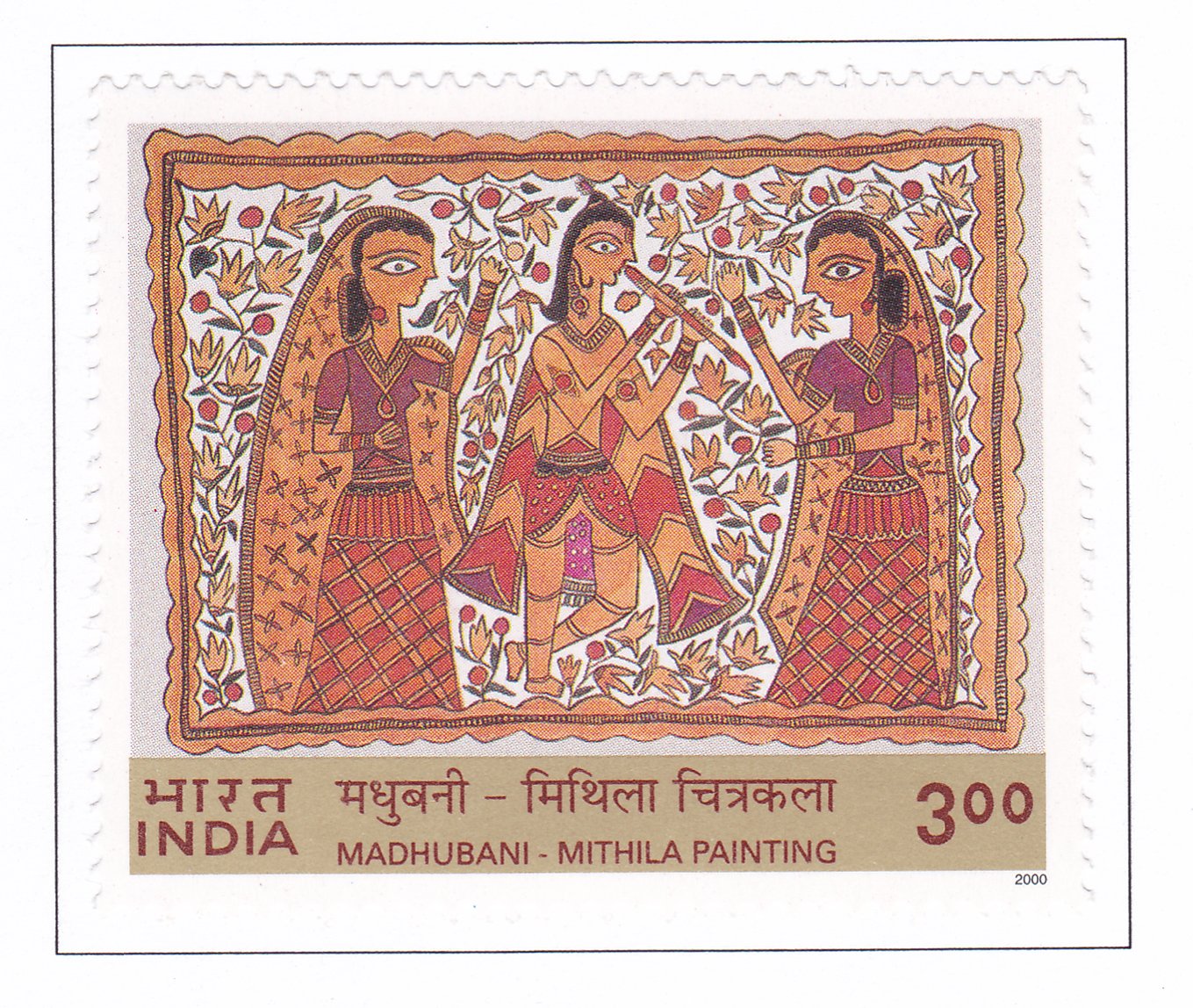“Krishna with Gopies” (Anmana Devi)

Technical Data
| Stamp Set | Madhubani Mithila Paintings |
|---|---|
| Date of Issue | October 15, 2000 |
| Denomination | Rs. 3 |
| Quantity | 3,000,000 |
| Perforation | comb 13½ |
| Printer | Calcutta Security Printers Ltd |
| Watermark | No Watermark |
| Colors | Multicolor |
| Catalog Codes |
Michel IN 1788 Stamp Number IN 1850 Yvert et Tellier IN 1554 Stanley Gibbons IN 1955 |
| Themes | Art | Paintings |
Table of Contents
Commemorative Stamp Set: “Krishna with Gopies” (Anmana Devi)
Design Elements:
- Central Figure of Krishna: The stamp showcases Lord Krishna playing the flute, adorned with traditional attire and surrounded by the Gopies (milkmaids). Krishna’s figure is central, depicted in a bright, dominant color with intricate detailing.
- Mythological Imagery: The Gopies are depicted in graceful postures, enchanted by the melody of Krishna’s flute. The composition portrays a dynamic interaction between the characters.
- Madhubani Art Style: The artwork follows the Madhubani style with its bold outlines, fine detailing, and the use of vibrant natural colors like red, yellow, blue, and green.
- Traditional Motifs: The background features typical Madhubani motifs like peacocks, floral patterns, and geometric designs, contributing to the richness and complexity of the visual story.
Cultural and Historical Significance:
- Mythological Significance: The depiction of “Krishna with Gopies” is inspired by a popular episode from Hindu mythology where Krishna, the divine lover, enchants the Gopies with his flute music. It symbolizes divine love and devotion.
- Cultural Heritage: This scene is central to Indian art and culture, frequently represented in various forms of visual art, music, and dance. It captures the devotional spirit of the people towards Lord Krishna and reflects the deep-rooted influence of mythology in everyday life.
- Expression of Bhakti: The Gopies’ devotion to Krishna is an important theme in Bhakti movement literature, symbolizing the soul’s love for the divine.
Usage:
- Commemorative: This stamp honors India’s mythological heritage, as well as Madhubani art as a medium for expressing religious stories.
- Cultural Representation: By using this painting on a stamp, India showcases its rich traditions of storytelling and folk art.
- Philatelic Value: Collectors with an interest in Indian mythology, folk art, and religious themes would find this stamp particularly significant.
Importance of the Commemorative Stamp Set:
- Preserving Mythology through Art: The stamp highlights the role of traditional art forms like Madhubani in keeping ancient mythological stories alive, especially among the younger generations.
- Feminine Perspectives in Mythology: The portrayal of Gopies reflects the importance of women in devotional practices and their deep connection with divine figures like Krishna.
- Promotion of Madhubani Art: By featuring the work of Anmana Devi, the set brings attention to the female artists who have contributed to the evolution of this art form.
Example of the Stamp Design:
- The design features Krishna standing amidst a group of Gopies who are mesmerized by his flute. Krishna is shown with his iconic peacock feather crown, blue skin, and playing the flute, while the Gopies are elegantly dressed, adorned with traditional jewelry. The background is filled with intricate floral patterns, trees, and peacocks, characteristic of Madhubani art. The bold use of natural colors gives the stamp a vibrant and lively appearance.
The Commemorative Stamp Set Might Include:
- Other Mythological Themes: In addition to “Krishna with Gopies,” the set might feature other Madhubani paintings portraying episodes from Indian epics like the Ramayana or the Mahabharata, showing the narrative depth of Indian folk art.
Significance:
This commemorative stamp set celebrates the mythological richness and cultural depth of India, using the traditional Madhubani art style. The “Krishna with Gopies” painting by Anmana Devi captures an iconic moment of divine love and devotion, making it a powerful representation of both spiritual and artistic heritage. Through this stamp, India promotes its vibrant cultural history while highlighting the artistry of rural women.
